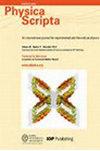光元素吸附调节 h-BC2N/g-C6N6 纳米带的电子结构
IF 2.6
3区 物理与天体物理
Q2 PHYSICS, MULTIDISCIPLINARY
引用次数: 0
摘要
利用第一原理方法计算了 h-BC2N/g-C6N6 纳米带的电子特性。设定了铁磁、反铁磁和顺磁耦合三种状态。结果发现铁磁耦合态的能量最低,表明最终的稳定态是铁磁耦合态。铁磁耦合态的热力学稳定性也得到了验证。h-BC2N/g-C6N6 纳米带本身具有磁性,磁矩为 2,是一种直接窄带隙半导体材料。为了改变其电子特性,在 h-BC2N/g-C6N6 纳米带中吸附了六种不同的原子(B、C、N、Al、Si、P),并研究了它们的带状结构和电荷密度。结果表明,h-BC2N/g-C6N6 纳米带吸附不同的原子会产生不同的结果。其中,N 原子和 P 原子的吸附使其性质从半导体变为半金属,可在费米面上产生 100% 的极化电流。这为自旋电子器件提供了更多的发展方向。本文章由计算机程序翻译,如有差异,请以英文原文为准。
Light elements adsorption modulates the electronic structure of h-BC2N/g-C6N6 nanoribbons
The electronic properties of h-BC2N/g-C6N6 nanoribbons were calculated using the first principles method. Three states of ferromagnetic, antiferromagnetic, and paramagnetic coupling were set. The energy of the ferromagnetic coupling state was found to be the lowest, indicating that the final stable state was the ferromagnetic coupling state. The thermodynamic stability was also verified in the ferromagnetic coupling state. The h-BC2N/g-C6N6 nanoribbons itself is magnetic with a magnetic moment of 2 and is a direct narrow band gap semiconductor material. In order to change the electronic properties, six different atoms (B, C, N, Al, Si, P) were adsorbed in the h-BC2N/g-C6N6 nanoribbon, and their band structure and charge density were studied. The results show that the adsorption of different atoms in h-BC2N/g-C6N6 nanoribbons will produce different results. Among them, the adsorption of N and P atoms changes its properties from a semiconductor to a half-metal, which can generate a 100% polarized current in the Fermi surface. This provides more development directions for spintronics devices.
求助全文
通过发布文献求助,成功后即可免费获取论文全文。
去求助
来源期刊

Physica Scripta
物理-物理:综合
CiteScore
3.70
自引率
3.40%
发文量
782
审稿时长
4.5 months
期刊介绍:
Physica Scripta is an international journal for original research in any branch of experimental and theoretical physics. Articles will be considered in any of the following topics, and interdisciplinary topics involving physics are also welcomed:
-Atomic, molecular and optical physics-
Plasma physics-
Condensed matter physics-
Mathematical physics-
Astrophysics-
High energy physics-
Nuclear physics-
Nonlinear physics.
The journal aims to increase the visibility and accessibility of research to the wider physical sciences community. Articles on topics of broad interest are encouraged and submissions in more specialist fields should endeavour to include reference to the wider context of their research in the introduction.
 求助内容:
求助内容: 应助结果提醒方式:
应助结果提醒方式:


